The velvet arrived for the altar cover that we’ve been working on here in the studio. It’s … whoa. So pretty!
I like blue and gold together. I like blue and silver together, too, but I really love blue and gold. There’s something extraordinarily regal about it.
Just so you can get an idea of where we’re going with the goldwork project that I’ve been covering here on the blog, today I’ll show you the velvet and then share some thoughts that were prompted by comments and questions from recent articles on the goldwork project I’m working on.
Incidentally, before we jump into that, I apologize for missing you on Monday. Four things happened: 1. we launched these new products, including colored linen sampler packs, Cohana scissors (which sold out), and some favorite needles; 2. I had a problem with my shipping app (of all days!); 3. I had an external disk drive problem (of all days!); and 4. We got in several shipments of things over the weekend that didn’t fit anywhere and had to be sorted out so we could actually breathe and move. It was a crazy morning! Something had to give, and unfortunately, it was a blog post that was supposed to be edited and published first thing.
But enough of that! Let’s talk about goldwork!
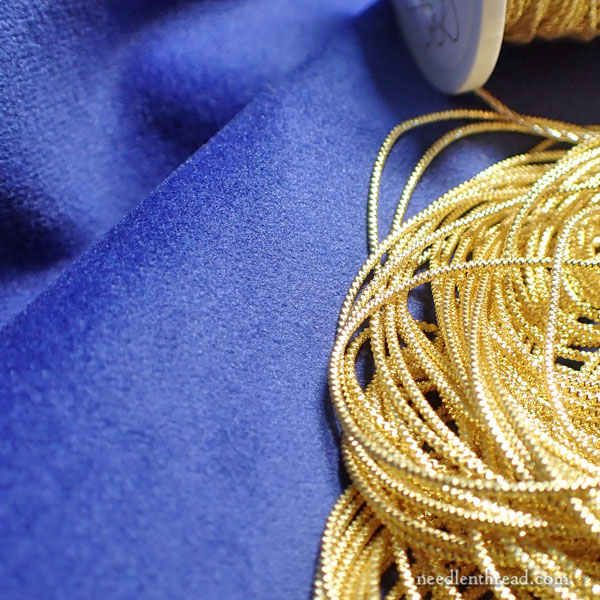
So, in the background above, you can see the glorious blue velvet that will serve as the background for the goldwork lettering we’ve been working on lately.
It is stunning stuff. It’s hard to photograph so you can really get the sense of how lovely it is. There’s something wonderful about velvet! This isn’t a slinky, really shiny, sparkly, stretchy type velvet like you might find in the clothing industry. It’s an upholstery velvet, with a beautiful drape, a subtle sheen, and the mesmerizing change of shade when the light plays on it that you find in fabrics with a nap.
Mmmm mmmm mmmm. It’s something.
I promise I will show you more of it when we come to the construction stage! And it may show up somewhere in between, too.
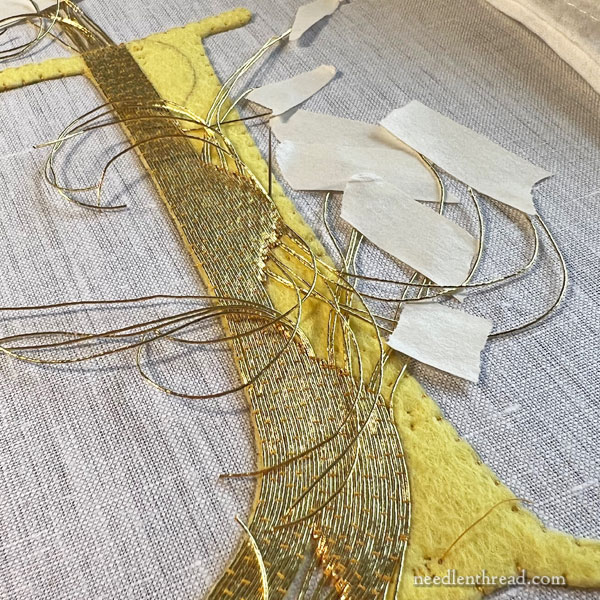
Along with the recent articles on this project, I’ve had a bunch of questions and comments coming in, so I thought I’d answer some of those.
First, will I be making a kit out of this? Several folks have asked. Oh, no, I’m afraid this is not a “kit-able” project. This project is huge and wouldn’t kit well. I’m simply sharing my own process while working through a major project, in hopes that some of the progress, tips, troubleshooting, and so forth can come in handy for the wider embroidery world. You might pick up some helpful tidbits. Or you might just enjoy watching a large embroidery project develop. It’s not going to be a kit.
Yes, You Can.
“I love goldwork, but I can’t afford real gold threads…”
“Are you going to recycle or sell the scraps…”
“I could never do goldwork…” “I’ll never have the skills for goldwork…” and similar.
My friends, please allow me to dispel some myths.
About expense: goldwork threads are not 100% gold. They are mixed with alloys so that the gold content is watered down to a very small, small percent. I’m working with gilt threads, so they contain maybe 0.5% gold, tops. And while goldwork threads seem expensive, they don’t require a ton of thread to get the coverage you need. So, they are not out of reach, when it comes to affordability.
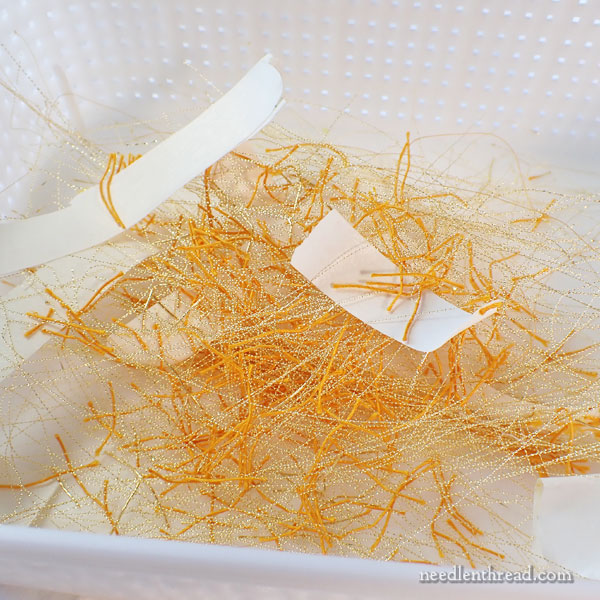
Those are thread scraps, above. As far as selling the scraps to scrap gold buyers, no. They wouldn’t be interested. They could never extract enough gold from gilt embroidery threads to make it worth their while. There’s really not much material value to it. Those will go in my orts jar where they will provide me with the pleasure of looking at a jar full of thread scraps that have a little sparkle to them, and that represent years and years of projects. The jar means little to anyone else, but I like it!
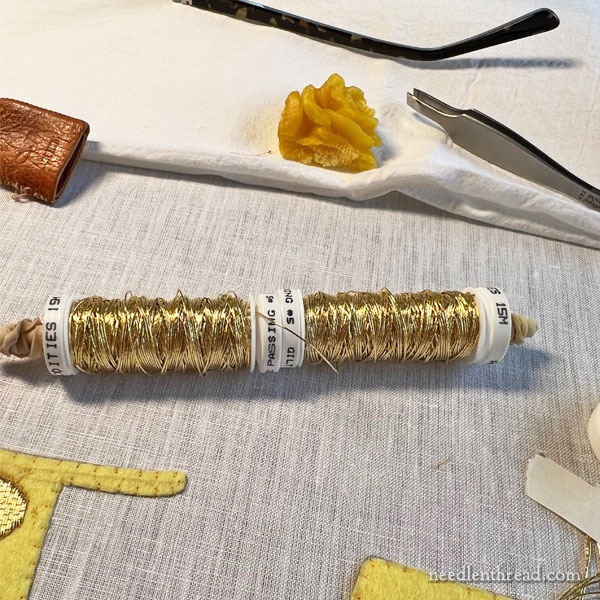
About do-ability:
If you want to learn goldwork, you definitely can. It is not complicated, not in the least.
For most goldwork embroidery, only one actual stitch is involved: the straight stitch. Truly! For most goldwork, you’re either couching over metal threads with a straight stitch, or you’re sewing cut metal threads on like beads, with a straight stitch. There’s not a lot about the stitching that’s complicated.
There are other types of goldwork, true, but for the most part, goldwork threads are sewn onto the surface of fabric using a simple straight stitch.
The most complicated part of most goldwork is preparing the foundations to stitch over (we have kept that very simple in this project, by working over a one-layer foundation of wool felt), if the project involves a foundation. Some projects don’t involve foundations at all.
The second semi-complicated part is how to end the threads. And that’s not really complicated. I’m afraid I overdid it when talking about plunging threads the other day. That more of exaggerated exasperation for effect. I hope I didn’t turn people completely off by it!
Resources
There are loads of online resources for learning more about goldwork, if it’s something you want to explore further. You can, for example, read through many of my past articles on goldwork projects by perusing this tagged list.
You can also learn a lot from goldwork books. The most thorough goldwork book out there is Alison Cole’s Goldwork Masterclass, which I’ve reviewed here (and which I happen to offer in my shop).
But there are other books, too. If you can get your hands on a copy at a reasonable price, Ruth Chamberlin’s Beginner’s Guide to Goldwork is wonderful for learning the couching part of goldwork embroidery, mixed with silk shading. The book focuses on a glorious sampler, and it makes goldwork completely accessible.
Another excellent all-around reference book is A-Z of Goldwork Embroidery published by Search Press, reviewed here. It’s a marvelous reference book, affordable, and inspiring!
Goldwork Techniques, Projects, and Pure Inspiration by Hazel Everett, reviewed here, is a fabulous book with projects and instructions.
You can find most of these books – and more excellent goldwork books! – listed on my Amazon Recommendations page, here, if you’d like to add them to your own library. They’re worth it!
You can also learn goldwork by working through kits created by embroidery designers. There are loads out there! Just google it. You’ll find all kinds of online resources for goldwork!
Ok. I’ve probably overdone it. I just don’t want to discourage people from trying goldwork. If it’s something you’re attracted to, try it!
We’ll be exploring more goldwork as this project progresses. I’ll try to add tips and techniques as we go, so that you can see that goldwork is accessible and exciting.
More to come!
This article contains an affiliate link to my Amazon Recommendations page, where you will find books and tools that I use and recommend and that are available on Amazon. The affiliate link means that Needle ‘n Thread receives a small commission for items purchased through the link, at no extra expense to you.


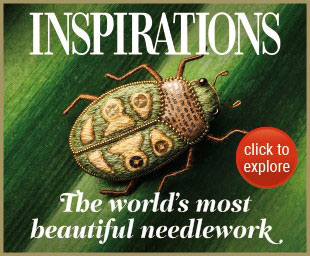



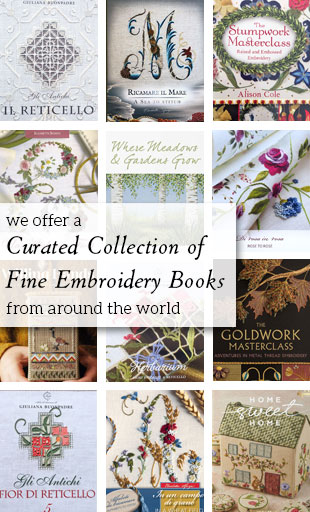
I’ve always wondered since I first read discussions of goldwork practice on your blog: Why don’t goldworkers just “U-turn” or boustrephodon* a continuous length of gold thread with a couching stitch at the very end of a line of couching, instead of cutting it and then having to plunge and tidy up All. Those. Ends? Speshly if you’re going to cover the ends of the lines with some kind of decorative edging later anyway.
Seems like the boustrephodon approach would save tons of time and effort as well as saving precious thread. Is the problem just that it would interfere with the look of the lines of gold thread by constantly reversing their orientation, or what?
* “Boustrephodon” or “ox-plow style” is a marvelous ancient term for the classical practice of writing lines of text in a back-and-forth motion like plowing furrows in a field, one line right-to-left and the next left-to-right and so on. 🙂
Oops I misspelled “boustrophedon” in my previous comment, but I hope that does not invalidate my question!
I used it in some parts, but not in others, because I prefer a very clean edge that’s provided by the sunk threads. If I do use it, I alternate the placement of it with every other double thread. You can see it in some of the letters, on some parts. It really depends on how much space I have for sinking threads (or not sinking them), etc. It’s an individual call, depending on the project, preferences in looks, and so forth.
I enjoyed reading your comments Kim, and particularly the term you shared for the U-Turn technique in gold work embroidery. What a fascinating word and etymology!
Now I’m no gold work expert – I’m just taking my first class – but the class design I’m following does use that technique for some elements in the design, and it does mean less plunging as you suggested. I’m grateful to you that I now know what to call it! 🙂
The element in my case is a petal, and I’m couching the lines round and round inside the shape rather like a snail shell. But at some point the corners became too tight to create a U-Turn without overcrowding the previously laid threads, making them bulge up from the padded base. So I had to unpick and plunge some of the threads to create the smooth finish I wanted.
So I guess from what I’ve learned, it’s a technique that’s useful in certain places as Mary said. I’m now off to practice saying that word – and hopefully pronounce it correctly! 🙂
Thank you for all the encouragement, and your project is looking beautiful.
The Royal School of Needlework/David & Charles self-paced online course in goldwork is very good, for those of us who like to see techniques being demonstrated.
Just a note to say that my Tulip needles arrived INCREDIBLY fast, like two days after I ordered them, and look great!
I always like ordering merchandise from N&T, even irrespective of liking the merchandise itself, because the order is always handled so professionally and efficiently and the packaging always manages to be not only secure and elegant but as minimal and sustainable as possible in its materials. I don’t know how you do it.
🙂 Thanks so much, Kim! I’m glad they arrived quickly and in good order!
I’m not quite sure how we do it, either, at this point. LOL! We have a lot of irons in the fire at the moment. Well, first thing’s first – we always do shipping right away, because I think it’s important to take care of the customer first.
I enjoyed reading your thoughts on gold embroidery, Mary, as I am just getting around to working through the Craftsy gold work embroidery class you recommended quite a few years ago now. I can understand why you say it’s a more reachable technique than a complete beginner imagines, and particularly if you are already reasonably adept at surface embroidery stitches.
I find for myself (with this particular class at least) that the challenge is more in observing carefully the demonstration and noting slight differences between that and my execution of the same and how that has affected my result in comparison. I hope that makes sense! So I have had to unpick and stitch quite a few of the stages twice to feel happy with the finish. That said, it’s approachable and I am enjoying the journey! So thank you for the recommendation. At one time, this seemed to be the only online option I knew of for learning this technique (the RSN online classes plus the effect of the pandemic seem to have created a welcome explosion in class opportunities) but this class is still a good choice methinks!
Plus thank you for your thoughts on what to do with the tiny thread remains – I was unsure as to their probable value and if I should be trying to recover/recycle them responsibly! So a Sparkly Orts Jar it is!